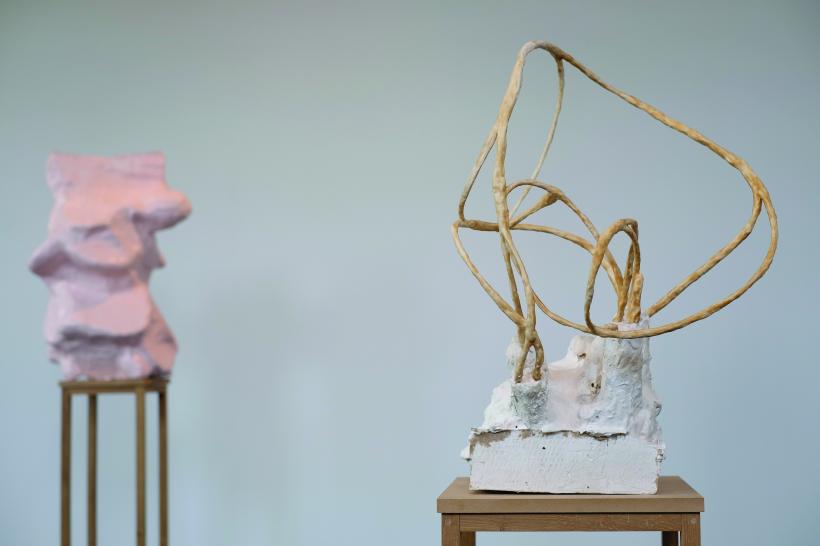A miniature army of wooden stools drawn on the back of an envelope has been reproduced on the invitation for Emma Donaldson’s exhibition ‘Making Trouble’. Appearing as stick figures, they pilgrimage into the unknowable, floating like suspended ghosts.
This is a sketch made by Armagh-based Donaldson during a research visit to St. Alban’s Museum ahead of her first major solo exhibition in the UK. The furniture vision has since been realised. The stools, now neat plinths, are arranged about the gallery and topped with things that Donaldson would describe as ‘objects’ rather than sculpture.
The spinal bluish white net of ‘navigated’ (2014) made from insulation foam, wire, newspaper, plaster bandages and paint, opens the exhibition. A stubby arm-like mass holds onto this structure as it is drawn away by an invisible force; a spindly creature tangle trying to pull itself away from its exoskeleton. A similar work, ‘drawing’ (2014), appears to come from deep under the sea, with its elongated tentacular suction cups releasing waxy swirls made from wire, latex and watercolour.
Donaldson has been supported by the Henry Moore Foundation for this exhibition, appropriate given the influence of the sculptor on her work. Moore can be seen in the bubblegum ‘Untitled’ (2014) - all boobs, elbows and knees. The object seems uncomfortable in its own skin, as if something wants to squirm its way out.
A makeshift cloud, ‘I will kill’ (2014), is made from old clothes, odds and ends of fabric bundled and trussed up, and appears unresolved. The needles used to sew it up in squiggling green, orange and black thread are still left hanging. Pins with small flower shaped plastic pin heads are placed without discernible function all around the mass of material, transforming it into a landscape or map to be navigated.
‘heaven’ (2014), is the only wall based work in the exhibition. Draped loops have an Eva Hesse drawn quality. The person, however, is missing and the abstraction, with its cheeky pigtail curls, becomes a hole instead, then a mouth, then a journey down into an oesophagus. Another throat-like formation can be seen in the unstable tower of Her (2014). A tailored cloth tunnel opens in a human ‘OH’ at its peak and the structure seems to tilt to the direction of this mouth’s in or outpourings.
Bodily references are found everywhere within Donaldson’s work. She is interested in ideas of ‘body memory’ - how experiences and emotions can leave their trace on the physical. The sculptural objects here have their own ‘sculpture memory’ and, perhaps, having been birthed for this exhibition, they also begin their own ‘exhibition memory’.
A tall white section of a mountain, wave or sawn off bill of a flat-billed platypus, towers towards the back of the exhibition in marshmallow white. Titled ‘she (i)’, it (or indeed she) appears to be in a state of very slight, almost imperceptible downward movement akin to the movement of tar or bitumen in pitch drop experiments. Created to see the flow in pitch over long periods of time, these ‘Tar Glaciers’ are still flowing after more than 100 years but look, to the eye, completely still.
Elsewhere, a rickety pastel pink tower, ‘the possibility’ (2014), is made from pine lengths, pins, pva, emulsion and car paint. The structure is already snapped towards its base and looks ready to give way. Next to this, ‘BASTARDS’ (2014), is the only object that incorporates the wooden stool plinth into the sculpture itself. Two black balls are attached to the oak stand stuffed with papier mache, cottons and nylon which look like grotty bathrobe belts from an old man’s bedsit.
With the repeated exposure to war-related work over the previous months, along with the Museum of St. Alban’s current exhibition relating to the Home Front, it is hard not to
see shadows of physical conflict in Donaldson’s work. Yet the works also have a cosy domesticity to them and politeness in their display. The scale, studio-size, sometimes suggests a future monumental moment. Donaldson is placed on the spectrum somewhere between the messy experiments of Phyllida Barlow, the sexier, curvier sides of Eva Rothschild and the loopy plasticines of the late Franz West but, like all of those artists, I want to see some more risk taking. This, I imagine, is still to come.










